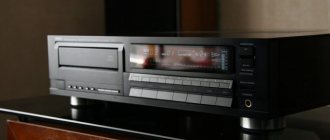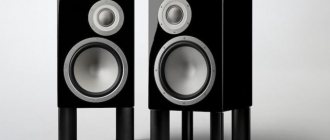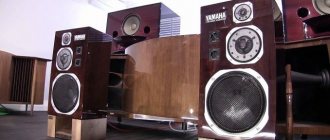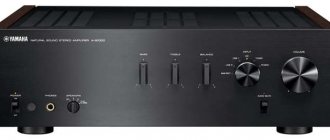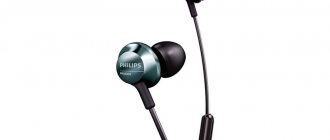Clash of the Titans: Onkyo Integra A-820RS VS Yamaha A-2000
Today I propose to take part in the battle of titans - top-class integrated amplifiers - Onkyo Integra A-820RS and Yamaha A-2000. The system in which the audition will take place is as follows: Speaker systems: JBL 4312B MK II Number of bands: 3 LF - 30 cm (paper on fabric with a coating similar to ceramic).
MF - 12.5 cm (fabric-based paper) HF - 2.5 cm (titanium) Speaker type: FI Sensitivity: 93 dB Frequency range: 45-22000 Hz Resistance: 6 Ohm. They are one of the best and most beloved speaker systems in the world, in their size (597x368x298 mm) and weight (21.7 kg). They are characterized by a spiritual, airy presentation, biting punch, and high resolution. Some recordings may focus on the middle, which is very good for jazz, especially vocal jazz, for example. Listen to them recorded on a good microphone: https://www.youtube.com/watch?v=D4_LGmd47kY
At my house, these speakers play exactly the same as on Kenrick’s recording - I recognize this sound 100%.
The companion CD player chosen was also a more than worthy Denon DCD 1650AL DAC: 4 pieces BB PCM1702, SM5845AF filter, Sharp H8147AF pickup. It is characterized by a daring sound that encroaches on the Hi-End - ultra-resolution, richness, naturalness, volume.
I couldn’t find the AL model in a good recording, but the AR plays similar in sound.
So what kind of amplifiers do we have? Well, first of all, this is the Onkyo Integra A-820RS - simply the highest and very expensive integrated model ever created by this company. Among Onkyo's integrated devices, only the model with a built-in DAC is more expensive - 2001, where it is more expensive by exactly the cost of the DAC itself (by 100,000 yen).
The Onkyo Integra A-820RS is certainly a grand model. It appeared in 1983 at an extra price of 175,000 yen. Of course, everything in this model spoke of belonging to the luxury class. Wooden sides shining with varnish, size, weight, daring combination of metal and wood. The amplifier belonged to the Integra series. Everything inside this magnificent audio car was also worthy - servo drive technology, two powerful independent power supplies, etc.
It was truly a luxurious car, from the word “luxury”. The superservo circuit, thanks to its complex operation, expanded the dynamic range by 20 dB. The amplifier chassis was made of non-magnetic materials. The characteristics of the device are as follows: Power (20Hz - 20kHz): 120W+120W (8 ohm) THD (20Hz - 20kHz): 0.007% (AUX) Frequency range: 5Hz - 100kHz (IHF, 3dB, THD 0.2%) S/N ratio: 100 dB (AUX) Weight: 23 kg. Of course, there are many more characteristics, I have given only some that are most interesting to me.
Second titanic amplifier
Yamaha A-2000 The luxury flagship from Yamaha, also released in 1983, priced at 189,000 yen. Those paying attention will notice that this is slightly more expensive than the price of the Onkyo A-820RS.
The Yamaha A-2000 amplifier was awarded a royal appearance similar to the internal flagship from Onkyo - the same polished wooden sides under piano varnish, but of a lighter color, conveying the texture of wood and mesmerizingly reflecting surrounding objects on its surface. The filling also corresponded to the luxury appearance - two transformers, one, the largest, worked only in class A, and the second only in AB, together they implemented a special circuit used in this flagship - ZDR - double class A, when the signal was amplified in class A and AB and combined to eliminate the slightest distortion. The load was connected to the output of each of the Class A amplifiers and the Class AB amplifiers.
The result of this was a sound similar to pure Class A, but with the incomparable power of Class AB. In general, this was an absolute extreme when the desire to get class A sound combined with the advantages of AB was adequately embodied - Yamaha's winning song, after which it, having received a truly audiophile device, no longer strained too much having a very strong rear. Let's look at some technical characteristics of the Yamaha A-2000 : Power: .005%) 130W+130W(8Ω,0.003%)
Reproducible frequency range: 10Hz~100kHz(THD 0.02%,65W,8Ω) THD: 0.002%(MAIN IN→SP OUT 65W/8Ω) SNR: 106 dB (AUX) Power consumption: 420 watts Weight: 26 kg .
Yamaha A-2000
What can you tell from the numbers? The Yamaha A-2000 is slightly more powerful than the Onkyo Integra A-820RS (by 10 watts per channel). The signal-to-noise ratio of the Yamaha A-2000 is 6 dB better. Let me remind you that the difference is not linear. For example, subjectively, the difference in volume between 89 dB and 92 dB is felt as twofold. The range of reproduced frequencies is formally larger with Onkyo, but in reality these indicators were taken under different conditions. In sum, we can say that the characteristics of both devices are more than high. I will also note such a detail as the thicker power cable made of oxygen-free OFC copper in the Yamaha A-2000 model. By the way, in the Yamaha A-1000 model, released the following year, this cable became much thicker.
LISTENING I connected the Onkyo Integra A-820RS first. As this very action progressed, I fully felt that the apparatus was heavy and there was no desire to push it further. For listening, I prepared discs, mainly vocal jazz and, to expand the picture, an album in the thrash metal genre. The following albums are responsible for jazz, which I recommend for listening:
David Benoit, Jane Monheit “2 in Love” David Hazeltine Trio “Alice in Wonderland” Diana Krall “When I look in your eyes” Norah Jones featuring… Megadeth “Cryptic writings”
MORE: Album David Benoit, Jane Monheit “2 in Love” - good female young jazz vocals, pleasant selection of songs, masterful performance.
David Hazeltine Trio “Alice in Wonderland” - jazz trio, piano, etc. - very similar to Bill Evans
Diana Krall “When I look in your eyes” is a wonderful album - beautiful guitar, keyboards, vocals, interesting songs.
Norah Jones featuring... is a collection in which Norah Jones sings with other famous artists. The album as a whole is excellent, with a very large number of songs of different styles. The entire album was disappointing only with 2-3 songs in the middle - an inappropriate duel with a rap artist.
Megadeth "Cryptic writings" is an excellent well-recorded thrash metal album. Mustaine's vocals are, as always, inimitable.
AND STILL LISTENING. ONKYO A-820RS The first disc I played on the Onkyo A-820RS was David Benoit. The high class of the device is immediately noticeable - the sound is delivered with a noticeable sweetness. The detail is high. Female vocals sounded good, but there was some roughness around the edges. On the one hand, one could say that the resolution is so high that the flaws in the recording are visible, but I don’t think that’s the case. I think the amplifier puts a slight emphasis in the upper register, which sharpens the sibilance a little.
I also did not understand the composition of the work itself. It plays nicely, smoothly, the detail is high, but the cohesion does not add up, I perceive the instruments not as a way to convey music, but as separate units. Since I did not understand some of the nuances, I decided to change the disc to a jazz trio, where, due to the small size of the group, I could understand that I felt “wrong.”
I put David Hazeltine Trio's "Alice in Wonderland" on the turntable. There are few instruments here, everything is played perfectly. I heard that yes, it plays great, pleasantly, not tiring, but again I heard sounds. But now it became clear what exactly confused me. I heard the cause and I heard the effect, but I could not connect them.
For example, a drumstick hits a cymbal. I separately hear the bright ringing of a blow on copper and completely separately hear the after-sound - a separate rustle of iron. The closest analogue I can give is - you are listening to 3-way acoustics and someone says - the bands are poorly stitched - here I hear a failure, but here, on the contrary, the volume seems to be superimposed. I had exactly the same feeling. My sound did not connect the source of the sound and its after-sound. The amplifier has an audiophile resolution, but there was one problem. I am actually sure that if I had installed a “smoother” and less detailed CD player into the system, I probably would not have seen this. But in this case, the setup included both ultra-resolution devices, one of which was top-class and was obliged to get the Moon out of the sky or at least a hamburger from McDonald's.
When listening to Diana Krall's “When I look in your eyes” - a very soft and calm album, I heard the same moments again. In my opinion, the volume of individual instruments was deliberately higher than it should have been. The piano could start playing very loudly in the right speaker and fade out in the left, but at the moment of transition the decay did not seem uniform to me. The guitar played louder and more clearly than I was used to hearing in this composition.
https://www.youtube.com/watch?v=dsR8G-LWMBg
In other words, I realized that my claim was only in one thing - unity, I lacked unity. Just imagine the musicians, they are starting a rehearsal. The point of rehearsal is the unity of sound, when each performer feels the other’s part and supports it by playing in unison, merging in a single impulse. When listening, I also want to hear complete unison between the performers. Here, the copper can unexpectedly grunt and the iron of the plate rustles separately. I can't connect these events. Do not take this description as a derogatory review, because this is a luxury device - most people reading this article most often have much lower class equipment and this device, if you listen to it, will be a dream come true - amazing detail and clarity, gorgeous stereo effect, sweetness of sound, lack of fatigue. All these qualities are present in the Onkyo A-820RS, but my goal is not to say - oh, what a super cool device this is, we all disagree. Yes, this is a cool device, this is the highest class, but I also see nuances, which may be a consequence of my specific perception and experience, but I see them and my goal is to note these points. Otherwise, you can take any glossy magazine and it will write about any device starting from $200, what the resolution is and what’s-its-name, this very scene. Of course it’s funny, because looking for scene and volume in entry-level and mid-level devices is really funny. Yes, I forgot to say, of course the Onkyo A-820RS gives surround sound, maybe I would like a little more air. Let's move on to Megadeth's "Cryptic writings" disc. He sounds great.
The amplifier is fast, its speed is more than enough to play metal and thrash. The above-described nuances with the sound in jazz are present here too. And I remembered one more thing, it seemed to me that the bottom was not controlled as confidently as I think the top flagship of the company should have done. Well, just imagine, they took this amplifier and grabbed it by the pincers... And if you twist it a little, it will immediately carry out even a hint of movement with lightning speed. I didn’t feel it here. You can check this, but not on yourself, but on your equipment.
AT THE LAUNCH OF YAMAHA A-2000 The Yamaha A-2000 is also a flagship, but, as you might guess, from Yamaha. And here I won’t describe it for a long time, because when I turned on the disc David Benoit, Jane Monheit “2 in Love” , seconds were enough for me to understand everything. Yamaha immediately flexed Herculean muscles; there was simply phenomenal control in the lower register. Each sound received unity, the cause was connected with the effect. I was hooked on David Benoit until I listened to the end of the album. Lots of air, lots of sweetness, lots of definition. Vocals have no sibilance, no “recording flaw”. Diana Krall also played magically, guitar, piano - everything was very harmonious, seamless. Maybe lower resolution? With ultra-resolution, you understand, this is not a very important question - do you hear ultra-resolution or ultra-ultra. Rather, the resolution is similar, it’s just that the playback is generally devoid of any roughness of the “recording”. David Hazeltine Trio "Alice in Wonderland" played very well, natural soft sound. Norah Jones featuring... also left an impression. I liked Megadeth “Cryptic writings” on Onkyo as well, but here one could say - this is what he really can do. Yamaha's flagship turned out to be an impressive machine.
RESULTS Here I must sum up some results of the listening, but there is nothing special to summarize. Onkyo Integra A-820RS is the flagship of the Onkyo company in 1983, which is a kind of variation on the super-servo drive scheme of the same top-end devices (but powerful ones) Onkyo M-509, etc. The 820RS is a truly impressive machine, luxuriously packaged, delivering insane ultra-resolution with loads of sonic detail, nuance and detail, sweetness and spaciousness. A titan from the world of audiophilia.
Onkyo M-509 - heavy artillery from Onkyo
It compares without question and is comparable to such powerhouse colossuses as the Onkyo M-506R, Technics SE-A5 or Pioneer M-90. These are tops from about the same years and then it was the edge of the audiophile sky, above which it would seem impossible to jump. All these listed devices are gorgeous, but what did Yamaha do?
Technics SE-A5 is a top-class device
I don't know what she did. It simply showed that, in addition to the solar system, there is also an immeasurable Universe (well, in fact, we are only interested in the distribution of matter, and it could not have spread further than 15 billion light years since the big bang due to speed restrictions by the speed of light within the limits known to us physics). In other words, the Yamaha A-2000 is a device of a different, higher class. Hi-End or Ultra Hi-End - here you can call it whatever you want.
WHAT WE LIKED
Yamaha A-2000 Excellent control over the lower register Amazing cohesion of sound Softness Punchy High resolution Sweetness Smoothness
Onkyo Integra A-820RS Sweetness Ultra Resolution Speed
In comparison, the Yamaha showed greater control over the lower register, being more careful about the nuances at the edges of sounds, naturally rounding them out rather than exposing them as artifacts.
AGAIN INSTEAD OF RESULTS Another thing you can try is to drive the flagship from Onkyo with other CD companions. Another question arose in me for a reason - my Yamaha A-2000 has completely undergone preventive maintenance; not so long ago, the quiescent current and other parameters were set according to the manual. I received the Onkyo A-820RS from Japan from its previous owner and I think it’s probably worth seeing if the currents correspond to what they should be (and whether this statement is appropriate in relation to Onkyo’s special superservo circuit).
Onkyo Integra A-820RS - top model
Let me remind you that the quiescent current affects the operating mode of the transistor; it is it that transfers the transistor to one of the sound classes - A or B, which also determines the sound you hear. Both devices we tested were very high-class, real flagships, but the Yamaha A-2000 seemed like a super-flagship. As a good friend of mine said, this Yamaha sounds at least 2 times more expensive than it costs, compared to similar competitors.
Yamaha A-2000 - top model
I completely forgot to include photographs of the entire event that took place. The pictures show used CDs and an Onkyo A-820RS (Yamaha A-2000 stands behind it on a glass shelf).
Yamaha CX-1/MX-1 Amplifier
The company defines the approach that Yamaha uses when creating its products as the purest: no compromises or external embellishment - everything to achieve perhaps the purest sound. A feature of this ideology is the simplest possible signal processing and, whenever possible, its direct transmission using extremely high-quality electronic components. In its ToP-ART series, Yamaha confirms this with its CX-1 preamplifier. On the front panel with smooth contours, there is clearly only a power button and two large knobs - a precision volume control with a scale digitized in dB, and a switch for seven signal sources. Under the cover there are non-operational controls and switches, among which, of course, there is a “Pure Direct” mode switch and a headphone jack. To achieve high quality sound, Yamaha used amplifier stages that use pure capacitive negative feedback and buffer amplifiers on all inputs. As a feature, we can note the possibility of switching three cassette decks and connecting MM or MC pickups. In addition to the head type switch, on the rear panel of the amplifier there is also a rather rare load switch for the MC head. The corrector circuit contains high-precision correction circuits (0.2 dB), has a high overload capacity (150 mV for MM and 6 mV for MS heads) and a “Subsonic” filter with a slope of -18 dB/oct. All input and output connectors are gold plated. Three power outlets on the rear panel allow you to connect a load with a total power of up to 200 W. The remote control makes it possible to switch the operating modes of the amplifier and also the cassette recorder, tuner and CD player. To control the power amplifier, which, unlike other components, does not have a remote control receiver, it must be connected with a special cable to the CX-1 included in the kit. Externally, the MX-1 power amplifier is made in the same manner as the preliminary one: an ascetic front panel with a large power button and a minimum of indication. Two separate power transformers and high-capacity filter capacitors (2 x 36,000 µF and 2 x 33,000 µF) together with high-power output transistors allow the amplifier to operate at a low-impedance load. The use of a linear amplifier damping circuit made it possible to significantly reduce the frequency dependence of this parameter and, as a result, improve the intelligibility of all sounds and frequency response. The symmetrical design reduced the spread of parameters across channels and reduced background and noise. Not only the connectors, but also the conductors of the printed circuit board are gold-plated. Input level controls located on the rear panel allow you to limit the amplifier's output power to the desired level. As a result, all this allowed us to create a very good audiophile kit, characterized by natural, clear sound and high output power. Listening to various tests showed good sound timbre, especially low frequencies, which is explained by the good power reserve of the power supply.
